
That’s one small step for man, one giant leap for mankind.
Neil Armstrong
Apollo 11 was without a doubt a historical moment as Neil Armstrong and Buzz Aldrin took humanity’s first steps on another planetary body on July 20, 1969. This first crewed mission brought not only humans but also left a flag of the United States as a permanent resident of the moon.
However, this is all common knowledge and probably not what you came for… So, what other countries have planted their flag on the moon?
The only countries to have successfully inserted a flag of their respective nations into the lunar soil are the United States of America and China.
Let’s take a look at how they did it.
The Flags of the United States
Contrary to popular belief, the United States flag planted into the lunar surface during the Apollo 11 mission was not the only one. Since 1969, a total of 6 US flags have been left on the moon.
Apollo 11
On July 20, 1969, Apollo 11’s Lunar Module (LM) Eagle performed the first successful crewed landing on the moon. Despite an Outer Space Treaty signed by the United Nations (UN) in 1967 forbidding claims of sovereignty over celestial bodies, a U.S. flag was planted by astronauts Neil A. Armstrong and Edwin E. “Buzz” Aldrin in the Sea of Tranquility.
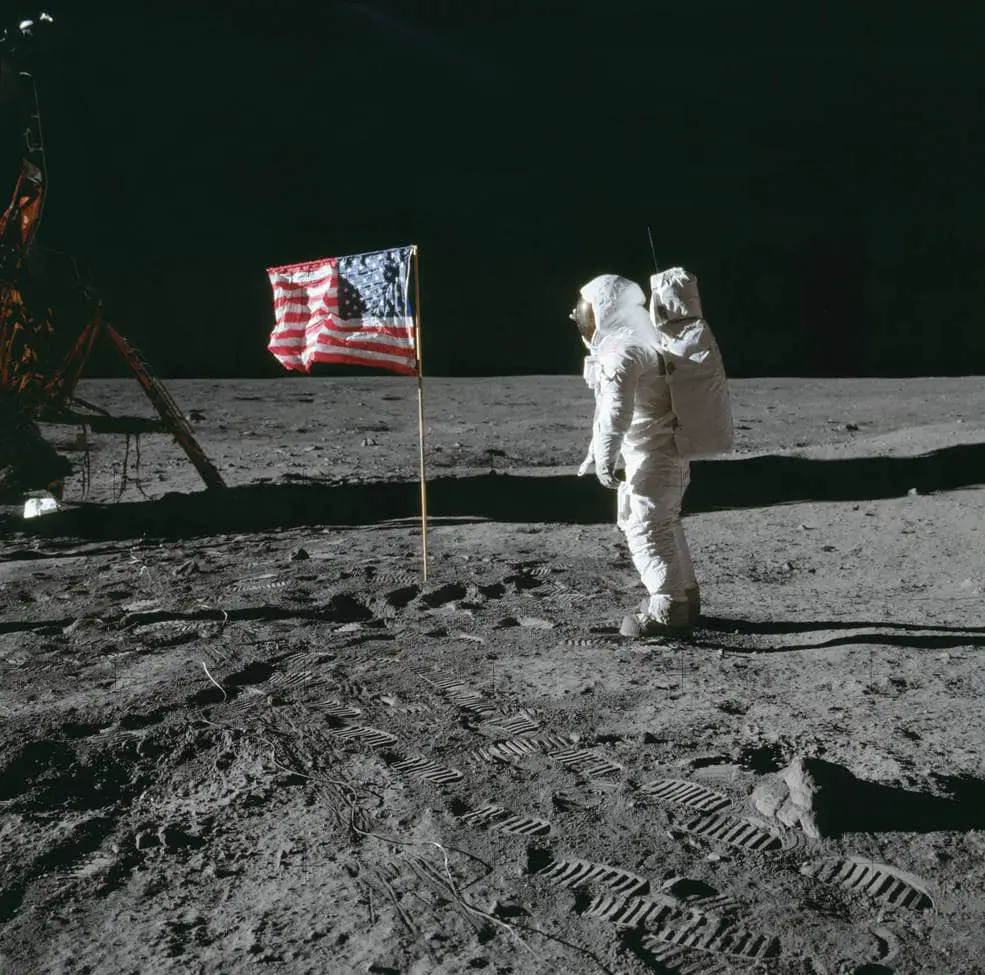
Image by NASA
Although, Buzz has unfortunately commented in his book Return to Earth that “There was no time to sight-see during liftoff. I was concentrating intently on the computers, and Neil was studying the altitude indicator, but I looked up long enough to see the flag fall over.” As expected, there was no indication of a flag shadow in the Apollo 11 Lunar Reconnaissance Orbiter Camera (LROC) images.
Apollo 12
On Nov. 14, 1969, even after struck by lightning, the Saturn V launch vehicle continued to fire and propelled the Apollo 12 Lunar Module into orbit, which after 10 days, made its successful landing on the lunar surface.
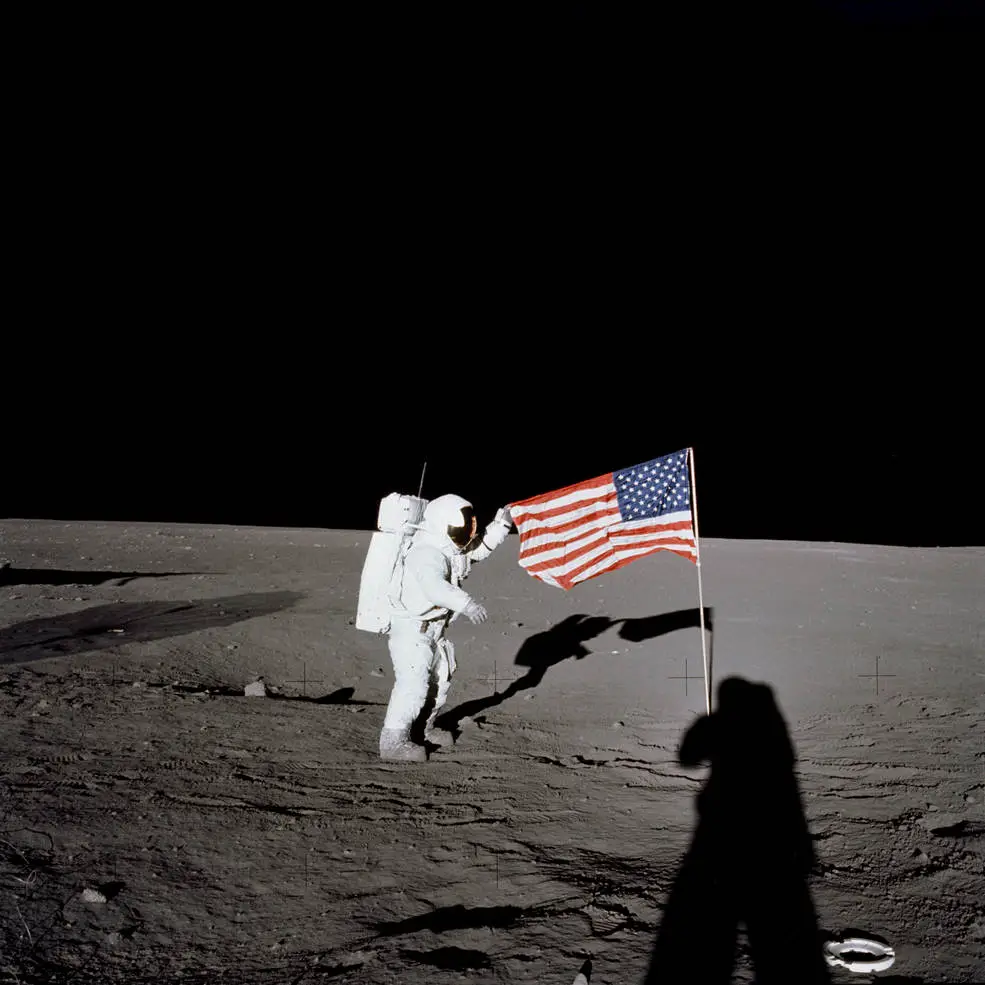
Image by NASA
Aside from Apollo 12’s primary mission objectives, the US Congress proclaimed the lunar flags to be “symbolic gesture[s] of national pride,” as a 0.91 m x 1.52 m flag was wedged by Commander Conrad in the dust of the Ocean of Storms.
An orbital view of the Apollo 12 landing site from LROC was taken in 2012, showing the shadow of the flag, which indicated that the flag is still there.
Apollo 14
Launched on Jan. 31, 1971, Apollo 14 was the eighth crewed Apollo mission and the third to land on the moon.
Despite docking problems and a faulty abort switch, Apollo 14’s Lunar Module landed successfully at Fra Mauro, where Commander Shepard planted the US flag.
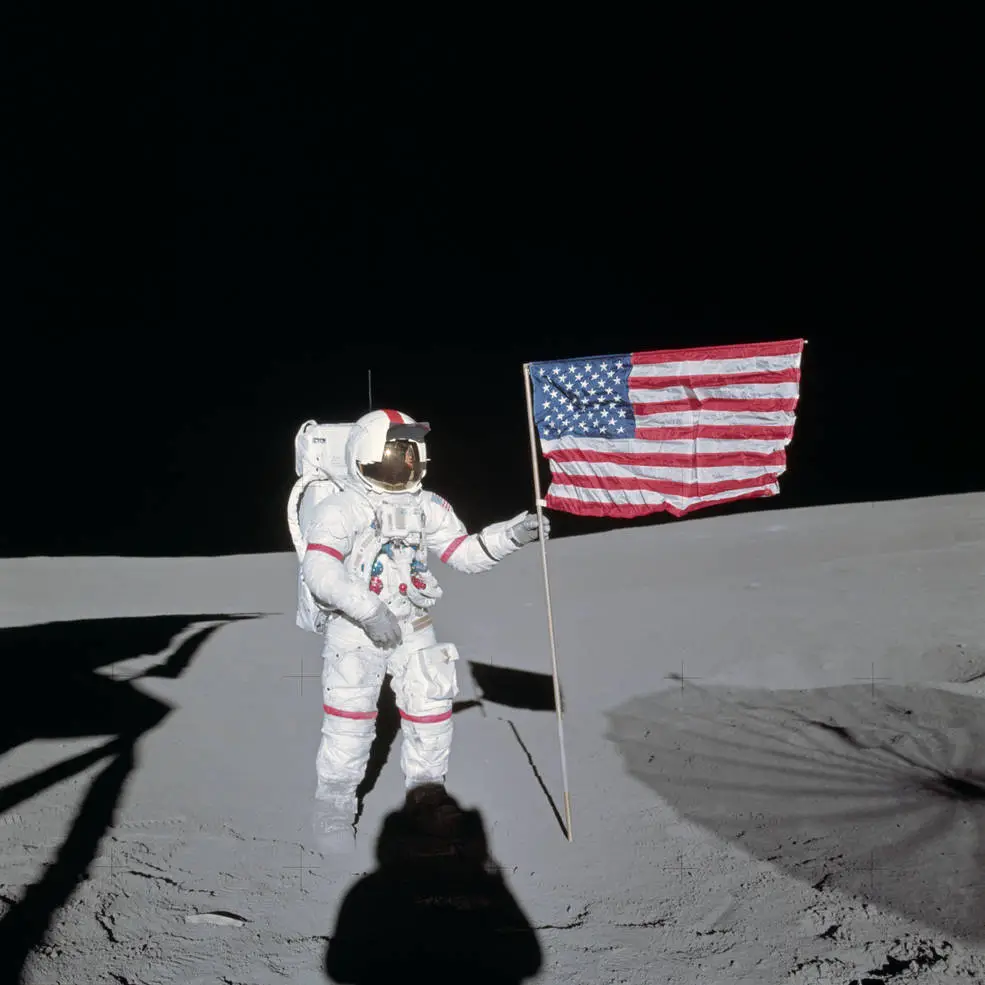
Image by NASA
The status of the Apollo 14 flag cannot be determined as there are no clear indications of a flag shadow from LROC images. This might be due to some combination of flag orientation, image resolution, or image brightness variation due to terrain rugosity, etc. It has also been speculated the Apollo 14 flag to have taken quite a beating from the LM engine exhaust during take-off.
Apollo 15
The Apollo 15 mission was special in its own right. Launched on July 26, 2917, It was the first of the Apollo missions capable of a longer stay time on the moon with greater surface mobility using the Lunar Roving Vehicle (LRV).
After landing successfully in the Hadley-Apennine region, the crew not only planted a US flag but also left the Fallen Astronaut – an aluminum statuette honoring the 14 (then) dead astronauts in space exploration.
Like the flag of Apollo 14, the status of the Apollo 15 flag remained a mystery, as images from the LRV-mounted TV camera showed that, a few hours after liftoff, the Apollo 15 flag remained standing. However, there was no clear evidence of a flag shadow in the LROC images.
Apollo 16
Touching down in the lunar Descartes Highlands on Apr. 20, 1972, the Apollo 16 crew drove more than 16 miles over three moonwalks on the Lunar Roving Vehicle and collected 209 pounds of samples. Included as an extra of the mission objectives, the Apollo 16 commander Younger also planted the US flag at the Descartes landing site.
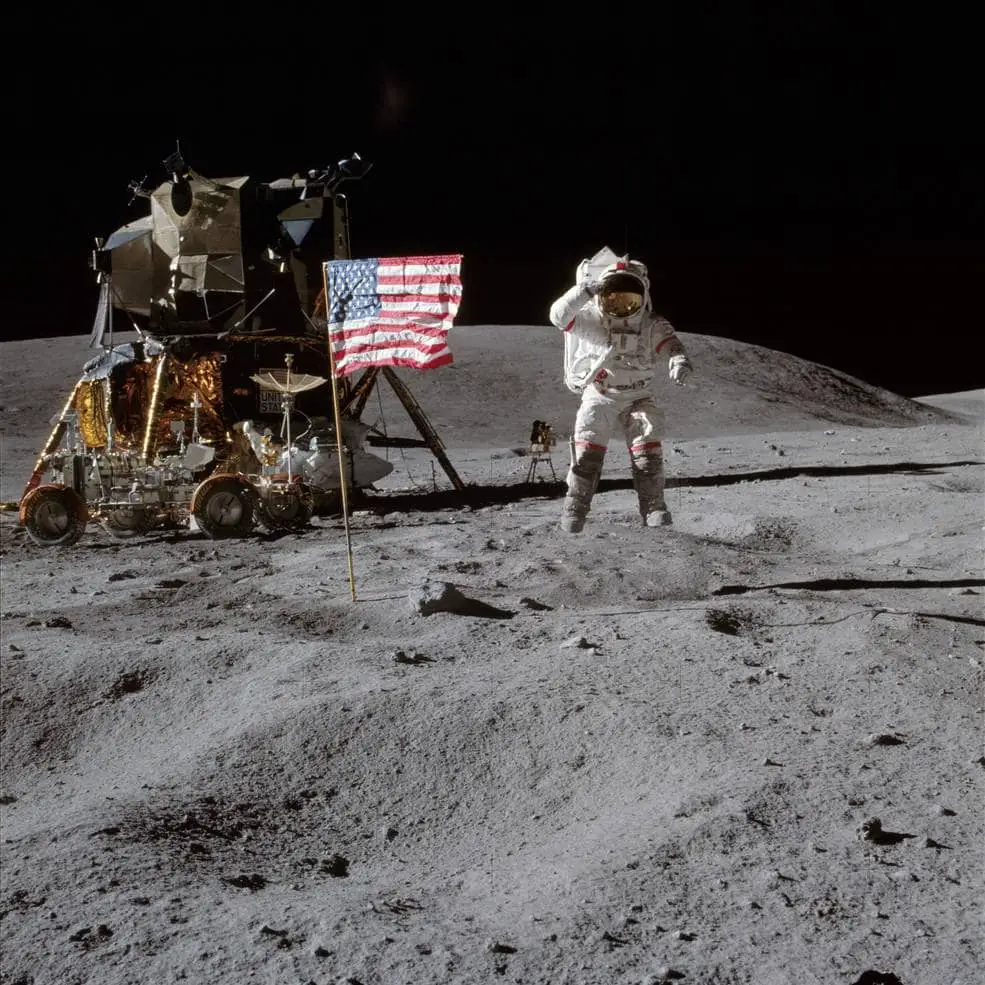
LM Orion and Lunar Rover in the background.
Image by NASA
In a sequence of seven LROC images, a strong shadow of the Apollo 16 flag remain visible. But based on a comparison of pre and post-ascent images, the pole does seem to be tilted 30 degrees off its local vertical.
Apollo 17
Apollo 17 was a mission of significance as it was the last human-crewed mission of humanity to the moon. With its extended hardware capability, larger scientific payload capacity, and the battery-powered Lunar Roving Vehicle, the Apollo 17 Lunar Module touched down in the Taurus-Littrow highlands and valley area on Dec. 10, 1972.
The moon flag of Apollo 17 was also special in its own right, as it was the flag that had hung in the Mission Operations Control Room (MOCR) through all prior lunar landings. This flag is 20% larger than the previous moon flags, and it now sticks firmly in the regolith of Taurus-Littrow.
Strong shadows of the Apollo 17 flag have been seen in a sequence of six LROC images, where a patch of soil disturbed by the crew during flag deployment and picture taking showed up clearly in the fourth and fifth images.
The Flag of China
More than 50 years after the US planted their flag on the lunar surface, China’s Chang’e 5 mission successfully landed on the moon in November 2020 and has successfully taken soil and rock samples back to Earth.
Aside from collecting lunar samples, the Chang’e 5 lander vehicle has also realized China’s first “independent display” of its five-star Red flag on the moon. However, the flag was not planted in the lunar soil but deployed from the lander’s body.

The Chang’e 5 lunar flag display system consisted of:
- The Flag
- Compression Release Device
- Pyrotechnic Deployment Mechanism
The entire system weighs about 1 kilogram and measures 0.5 meters long. The flag itself was designed to remain wrinkle-proof and unfold in the form of a scroll.
All parts of the flag have been given features for protection against the harsh lunar environment. The flag itself was made out of a new type of composite material so it can “maintain its true colors” under a temperature difference plus or minus 280 degrees Fahrenheit (150 degrees Celsius) [Space].
The “Flags” of the Soviet Union
In all sense of the matter, the Soviet flag was technically the first to reach the surface of the moon.
In the 20th Century, the Space Race between the two Cold War adversaries, the Soviet Union (USSR) and the United States (USA), spurred on the scientific advancement in the space domain. The race soon brought the nations to the moon, when in 1959, the Soviet Union took another step forward in its space program with the launch of the Luna-2 probe.
Luna-2 was the sixth attempt of the Soviet Union to impact the moon, which ultimately succeeded to become the first man-made object to reach the lunar surface. With a crash landing mission directive, the Lunar-2 detonated two sphere-shaped pennants prior to impact.
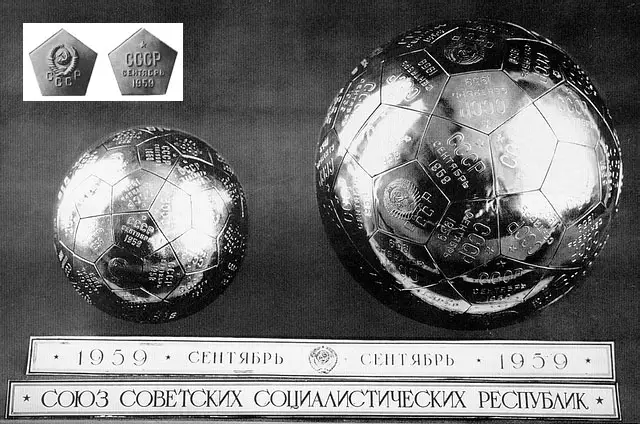
72 titanium alloy pentagonal elements covered the two pennants. The center of the spheres was an explosive designed to detonate on impact to scatter the tiny pentagons all across the moon. The centerpiece of the sphere contained the state emblem of the Soviet Union with the Cyrillic letters CCCP (“USSR”) and the launch date engraved below it.
Although these pennants were not “flags” in any sense of the word, they did carry with them the Soviet pride and served as evidence of humankind’s first presence on another celestial body.
References
- Six Flags on the Moon: What is Their Current Condition? (n.d.). NASA. https://www.hq.nasa.gov/alsj/ApolloFlags-Condition.html
- Lunar Flag Assembly Kit. (n.d.). Derek Beaulieu. https://derekbeaulieu.files.wordpress.com/2017/09/lfak-no-press-compressed.pdf
- David, L. (2020, December 7). China plants its flag on the moon with Chang’e 5 lunar lander (photo, video). Space.Com. https://www.space.com/china-flag-on-moon-chang-e-5-lunar-landing#:%7E:text=Chang’e%205%20broke%20ground,%2Dproof%2C%20Chinese%20officials%20said.&text=The%20six%20Apollo%20missions%20that,1972%20all%20planted%20American%20flags.
- BBC News. (2020, December 4). China becomes second nation to plant flag on the Moon. https://www.bbc.com/news/world-asia-china-55192692
- Dar, Y. (2020, December 6). Why China Is The Third Country, Not Second, To Put Their Flag On The Surface Of The Moon? Latest Asian, Middle-East, EurAsian, Indian News. https://eurasiantimes.com/why-china-is-the-third-country-not-second-to-put-their-flag-on-the-surface-of-the-moon/
- Mars, K. (2019, June 18). Flag Day – Flying High: The Stars and Stripes in Space. NASA. https://www.nasa.gov/feature/flag-day-flying-high-the-stars-and-stripes-in-space/
